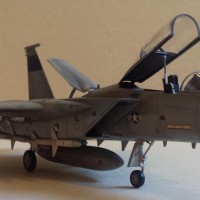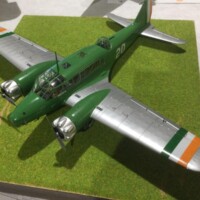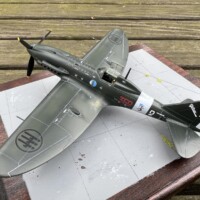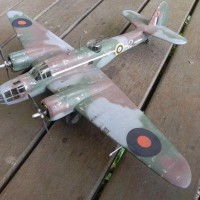Mars attacks! Or, a little more peacefully, a flying boat in XXL: Martin Mars flying tanker
How can you start a report on the Martin Mars? The first obvious thought is to start with its size,,the opening by its size, because after all, the original of this modelling project is the largest flying boat ever built in series! A wingspan of an enormous 61 metres and a length of no less impressive 35.7 metres can only be described with superlatives. A comparison with other giant flying boats is interesting in this context, as it makes it even clearer what the unique dimensions of the Martin Mars are all about: the German Bv 222 Wiking, the largest flying boat of the Second World War, had a wingspan of 46 metres with a 37-metre-long fuselage; the Japanese Kawanishi H8K2, on the other hand, was significantly smaller with a wingspan of just over 37 metres and a fuselage length of 28 metres, and even a post-war flying boat from the same stable as the Mars, the Martin P5M Marlin, fell well short of the dimensions of this flying giant with 36 metres from wing tip to wing tip and a 30-metre-long fuselage.
For its part, the Martin Mars is only surpassed by one flying boat: Howard Hughes' unique H-4 “Spruce Goose”, with a wingspan of 97 metres and a 66-metre-long fuselage, can lay claim to being the largest flying boat ever built - even if it only covered a few metres in ground effect during its first and only flight. Modern times have managed to surpass former records: an Airbus A-380 with a wing length of 79.8 metres and a fuselage of 72.7 metres is in a league of its own. But that's enough about the dimensions! Well, the size of the 72-metre reduction will be discussed again later.
The Martin Mars as a transocean transporter
The aircraft, originally called the JRM Mars, was designed for a very specific scenario: after the construction of the first prototype XPB2M in 1941, which had been designed as a maritime patrol aircraft, the US Navy as the client changed its requirements: the flying boat giant was now to be used as a transporter. Increasing numbers of ships being sunk by German submarines gave rise to the idea of moving troops and cargo by aeroplane - on ocean-spanning routes. The prototype was subsequently converted into the XPB2M-1R and used as a transporter from 1943 to 1945.
In January 1945, the US Navy ordered 20 of these huge flying boats, an order that was reduced to six after Japan's surrender. The designation of this first series, which was changed to JRM-1 (Model 170A), had a good reason: unlike the prototype, the production Mars no longer had a twin tail unit, but a single high fin. In keeping with established flying boat tradition, the individual aircraft were given names that referred to the destinations they most frequently flew to.
This resulted in the Philippine Mars (76820), Marianas Mars (76821), Marshall Mars (76822) and (two) Hawaii Mars (76823).
The last Martin Mars (76824) delivered in July 1947 was completed as the JRM-2: this aircraft, christened Caroline Mars, was powered by four Pratt & Whitney R-4360-4T Wasp Major engines, each rated at 3000hp. Three further JRM-1s were upgraded to the new standard in 1950 and subsequently designated JRM-3.
A second life as a fire-fighting aircraft
Even though the US Navy began to replace the Martin Mars with the Convair R3Y in 1956, this did not mean the end for the existing fleet of this powerful flying boat! In the same year, the Canadian company Forest Industries Flying Tankers (FIFT) acquired four Martin Mars to be used for fighting forest fires.
The conversion was carried out by Fairey Aviation of Canada in Victoria. The Mars flying boats were now able to pick up 27,216 litres of extinguishing water within half a minute by flying at 130 km/h just above the surface of the water. The extinguishing water was dropped from a height of 50 metres - pictures alone give an idea of what an impressive and beneficial spectacle this must have been, but only those who actually saw it know what it really ‘felt' like!
The Marianas Mars was lost in a crash in 1961 and the crew of four died. When Caroline Mars fell victim to a storm only a short time later, only Hawaii Mars and Philipine Mars remained available for firefighting operations. When FIFT was taken over by Coulson Aircrane Limited in 2007, the Philipine Mars had already been on the ground for some time, so its transfer to the National Museum of Naval Aviation in Pensacola came as no surprise.
Although it was repainted in its original Navy colours, it surprisingly remained with Coulson. As late as 2015, however, both aircraft were still registered as operational firefighting aircraft with the registration numbers C-FLYK and C-FLYL .
An interesting detail from these years is that the Hawaii Mars has been chartered out to the International Test Pilot School again and again since 2015. The reason: Chinese pilots and technicians used the giant seaplane to train their missions on the new Chinese large flying boat Avic AG600.
2024 was the last season for the two giant flying boats as firefighting aircraft. Exorbitant operating costs and a worsening shortage of spare parts made the decommissioning of the two Mars unavoidable. For the two aircraft, which had become legends over the course of their many years, this could only mean one thing: an honourable retirement in an appropriate museum!
On 11 August 2024, the Hawaii Mars set off on its last flight. It took off once more from Sproat Lake to fly to Victoria Airport Water Aerodrome near Victoria International Airport under the honourable escort of the Snowbirds aerobatic team. There it is now part of and the main attraction of the exhibition on the history of aerial firefighting. The Philipine Mars will also take off for one last flight in the near future: it is to become part of the exhibition at the Pima Air & Space Museum in Tucson, Arizona.
About the model and kit
Even as a model, the Martin Mars goes beyond both its dimensions and the scope of the usual: the first surprise came with the first glance into the large kit box. Instead of the expected amount of plastic, I was greeted by a half-built fuselage and wings made of fibreglass. In fact, I was additionally surprised by the small number of parts that would apparently be needed to build the large model.
The fact that I had no experience with fibreglass was evident from the damage I had already caused to the rather brittle and crack-prone material after a short time. This was exacerbated by the need to saw out the segment moulded into the fibreglass that covered the cockpit section. This was not so easy and was to lead to numerous repairs and a lot of filling and sanding work.
You have to be self-initiative when it comes to joining the heavy and far-reaching fibreglass wings to the fuselage. A 2-component adhesive is absolutely essential for this, which must be applied really well: the bending forces are high and the massive wings form a devilishly good lever, which quickly causes a gap to appear between the fuselage and the wings!
One circumstance that requires careful consideration is the need to drill a large number of portholes into the fuselage. Care must be taken to ensure that the openings are the right size and, above all, that splinters can be torn quickly and unsightly from the capricious material during drilling. To complete the picture: to protect my health, I only ever worked on the material with full respiratory protection and holding the model under running water; a job that is made more difficult in this way and quickly became quite sweaty!
Once the fuselage, wings and tail unit are combined, the most difficult part is over for now. One issue that comes to the fore, however, is the unwieldy size of the large model. A Martin Mars body shell requires a lot of space and room when it is moved across the surface of the workbench. You really do have to move the model a lot, as it requires a lot of filling and sanding.
One thing I noticed when painting is the poor adhesion of paint to the surfaces. I carefully cleaned, degreased and lightly sanded the fibreglass parts right at the start, but paint still kept sticking to the adhesive tape when I removed the adhesive masks. This is particularly annoying in the late painting stages, when the surfaces are almost finished. In retrospect, however, I think this can be attributed to my inexperience with the material. With the components made of the familiar polystyrene, which are mostly used for the engines or the floats, you have to reckon with a relatively large amount of reworking and quite rough casting quality.
To emphasise the size and impressive volume of Mars, I soon decided to depict it flying. The two pilot figures - from my inventory - were intended to emphasise the size with the human scale; in flight, the beautiful shapes and volumes of the flying boat would be easier to see. I tried to depict the rotating propellers necessary for this representation in the usual way using thin transparent film and very thinly sprayed dark paint.
To finish on a positive note: the decals proved to be of good quality on a really fine carrier film and can be used without hesitation. However, my overall résumé should also be positive! Anyone who buys this expensive model will have already informed themselves about what to expect and considered what they are prepared to take on. Once you have completed this giant model with the necessary consistency, you will be delighted to have taken this unique opportunity to build a Martin Mars. It really does look impressive and magnificent - a unique sight, both as an original and as a model!












































Roland, @rosashsenhofer, that is a very well done build of a very impressive plane. It looks massive even in 1/72nd scale. I love the colorful scheme, it really makes it stand out. Well done display also, great spinning props effect.
I was fortunate enough to see one of these fly when it was stationed here in Lake Elsinore, Califonria. I watched it doing practice runs right by my house, those pilots have some skills!
A true work of art!
Looks awesome- what is the brand of the kit?
I greatly regret selling off my 1/144 VacuForm MARS (I think Welsh models) more than a few years back...
Remarkable build, Roland. Amazing work, nice work with the fiberglass and with the props in motion.
I had a few posts on my FB when the Hawaii Mars made its departure flight, it made the CBC News.
The Snowbirds did an accompaniment flight also that day and posted a video on their Instagram page:
https://www.instagram.com/cfsnowbirds/reel/C-lgUT8S9lw/
G’day Roland (@rosachsenhofer),
Astonishing.
That’s amazing, Roland.
@rosachsenhofer amazing journey. You must be proud to have this completed. The prop blurs really sell the final depiction. Great build all the way around. Remember—half the victory is the journey.
Excellent model.
My friend lives in the BC interior. The town he lives in was partially saved by the Hawaii Mars this year.
Awesome work!
I didn't know anyone had created a kit of this massive plane, Roland (@rosachsenhofer). Working with fiberglass is not an easy job, especially if you haven't worked with it before. Your results are magnificent.
Yeah, astonishing, that's it.
This was a special treat, thank you.
Fantastic job and amazing result, Roland!
Congratulations!
“Magnificent” Is indeed the word for your Mars In flight project, Roland. Love those pilots.
Indeed superlative in dimensions but also the quality of your build, Roland @rosachsenhofer
Well done.
Wow - one big aircraft, and so well done. Thanks for the informative article also!
Awesome build of that big beast - a real masterpiece!
I am very impressed by your reactions - and of course delighted! Let me say thank you for your interest and enthusiasm, I really appreciate your words!